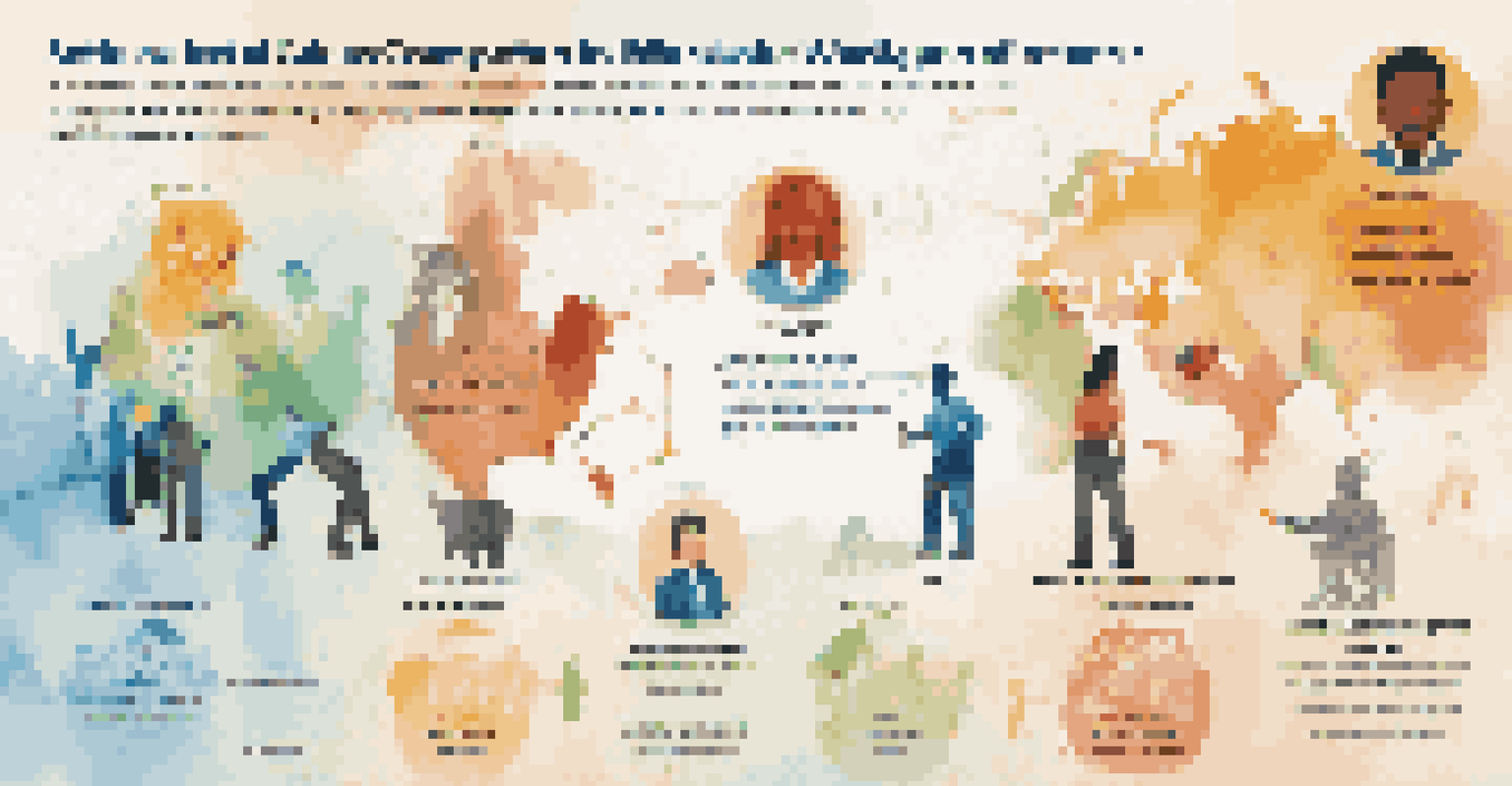Cultural Competence: Navigating Diversity in Business Teams

Understanding Cultural Competence in the Workplace
Cultural competence refers to the ability to interact effectively with people from diverse backgrounds. It encompasses understanding different cultural norms, values, and practices, which can significantly impact workplace dynamics. In an increasingly globalized world, developing this competence is essential for fostering collaboration and innovation.
Diversity is the one true thing we all have in common. Celebrate it every day.
Imagine working on a team where every member comes from a different cultural background. Each person's unique perspective can lead to more creative solutions, but misunderstandings can also arise. By cultivating cultural competence, team members can navigate these differences, leading to a more harmonious work environment.
Ultimately, cultural competence is not just about being aware of diversity; it’s about actively engaging with it. This engagement creates an inclusive atmosphere where everyone feels valued, leading to improved morale and productivity.
The Importance of Cultural Awareness in Teams
Cultural awareness is a critical component of cultural competence. It involves recognizing and appreciating the differences that each team member brings to the table. When team members understand each other's backgrounds, they are less likely to make assumptions that could lead to conflict.

For example, a team member from a collectivist culture may prioritize group harmony over individual accolades. Understanding this can help other team members adjust their communication style and management approach accordingly. This awareness fosters mutual respect, which is vital for effective teamwork.
Cultural Competence Enhances Teams
Developing cultural competence fosters collaboration and innovation by enabling team members to effectively engage with diverse backgrounds.
Moreover, cultural awareness can enhance problem-solving abilities within a team. By leveraging diverse viewpoints, teams can tackle challenges from various angles, ultimately leading to more comprehensive and innovative solutions.
Building Trust Across Cultural Lines
Trust is the foundation of any successful team, but it can be challenging to establish across cultural lines. Different cultures have varying norms regarding communication, personal space, and relationship-building. Being aware of these differences is crucial for creating a trusting environment.
Strength lies in differences, not in similarities.
Consider a scenario where one team member values direct communication, while another prefers a more indirect approach. By recognizing these styles, team members can adapt their interactions to foster trust and understanding. This adaptability is key in preventing misunderstandings and promoting open dialogue.
Establishing trust can lead to more candid conversations and a willingness to share ideas. As trust grows, team cohesion improves, making it easier to work together towards common goals.
Effective Communication in Diverse Teams
Effective communication is paramount in any team, but it becomes even more critical in culturally diverse settings. Different cultures have unique communication styles, and being mindful of these can help avoid misinterpretations. For instance, some cultures may value silence as a sign of thoughtfulness, while others might view it as discomfort.
To navigate these differences, team members should practice active listening and be open to clarifying questions. Encouraging a culture where individuals feel safe to express themselves can help bridge communication gaps. This practice not only improves understanding but also fosters a sense of belonging.
Trust Bridges Cultural Differences
Establishing trust across cultural lines is crucial for open communication and teamwork, as differing norms can impact relationship-building.
Additionally, utilizing visual aids or written communication can help ensure that everyone is on the same page. By adapting communication methods to suit the diversity of the team, members can enhance collaboration and productivity.
Embracing Diversity as a Strength
Diversity is often seen as a challenge, but it can also be a powerful strength. When teams embrace their differences, they open themselves up to a wealth of ideas and perspectives. This can lead to innovative solutions that a more homogenous group might overlook.
For instance, a marketing team composed of individuals from different cultural backgrounds can create campaigns that resonate with a broader audience. By considering various cultural contexts, the team can craft messages that are more inclusive and impactful.
Embracing diversity also enhances a company's reputation. Organizations known for their commitment to diversity and inclusion often attract top talent and loyal customers, ultimately contributing to long-term success.
Training for Cultural Competence Development
To foster cultural competence within teams, organizations can implement training programs focused on diversity and inclusion. These programs can cover various topics, including unconscious bias, cross-cultural communication, and conflict resolution. By equipping employees with these skills, businesses can create a more inclusive culture.
Imagine a workshop where team members share personal experiences related to culture. This not only builds empathy but also encourages dialogue about differences and similarities. Such initiatives can break down barriers and strengthen relationships among team members.
Diversity Drives Innovative Solutions
Embracing diversity allows teams to leverage varied perspectives, leading to more creative and impactful solutions in the workplace.
Regular training sessions can also serve as a reminder for employees to continuously reflect on their cultural biases and assumptions. This ongoing learning process is essential for maintaining a culturally competent workforce.
Measuring Success in Cultural Competence
To understand the impact of cultural competence initiatives, organizations should establish metrics for success. This could involve conducting employee surveys to gauge feelings of inclusion and satisfaction within the team. Additionally, tracking team performance and collaboration can provide insights into the effectiveness of cultural competence efforts.
For example, if a team that underwent cultural competence training shows improved project outcomes and stronger relationships, it may indicate that the training was successful. Monitoring these metrics allows organizations to make informed decisions about future training and development.

Moreover, sharing success stories within the organization can inspire other teams to embrace cultural competence. Celebrating achievements fosters a culture of continuous improvement and reinforces the value of diversity in the workplace.